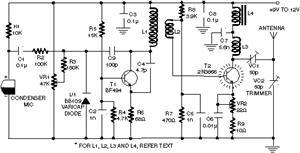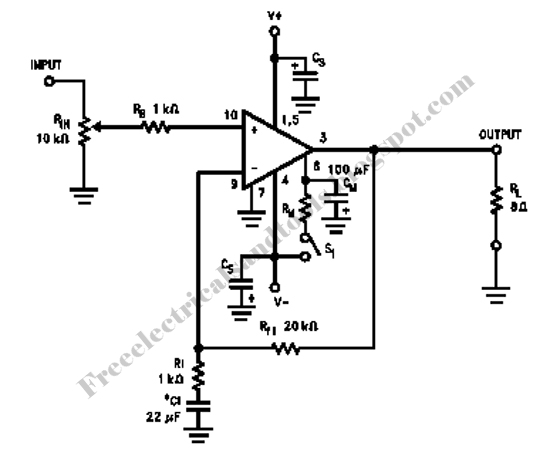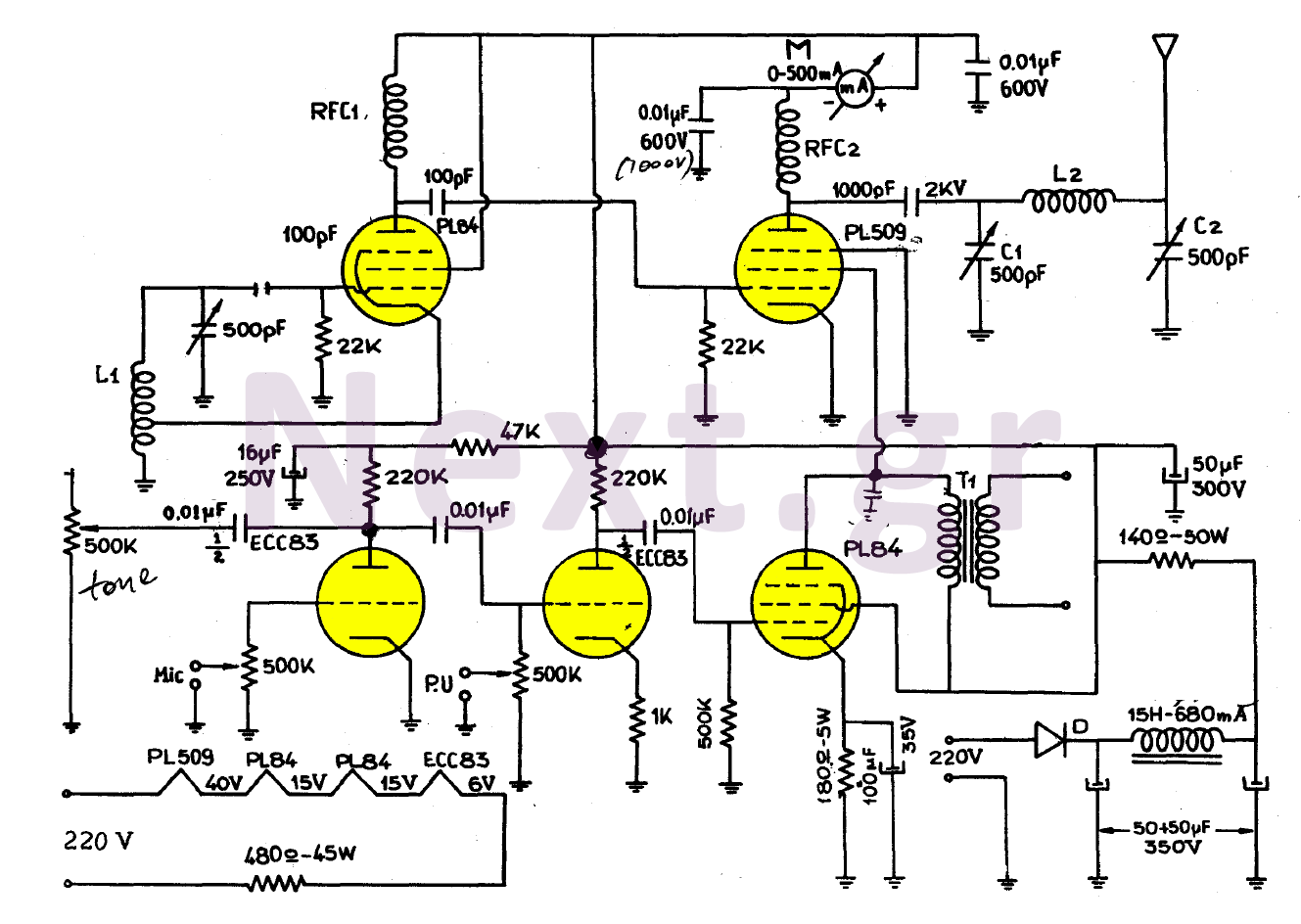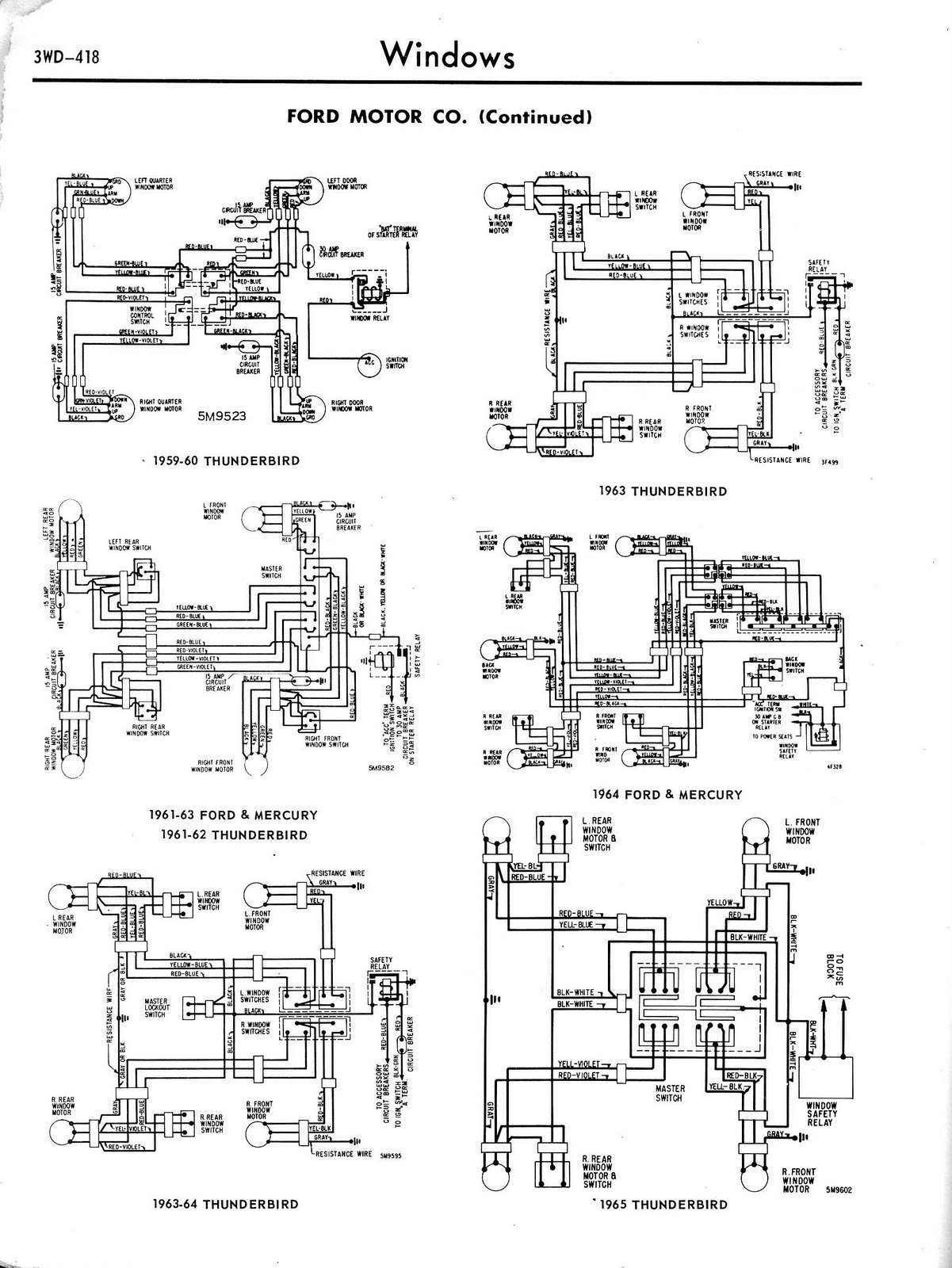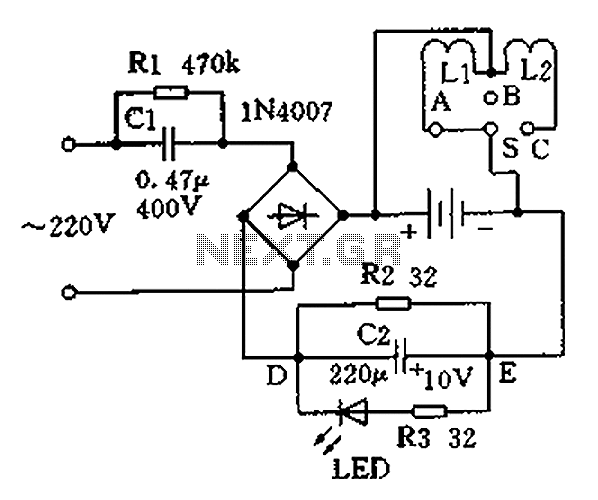
Simple Indicator for Dynamic Limiter Schematic Diagram
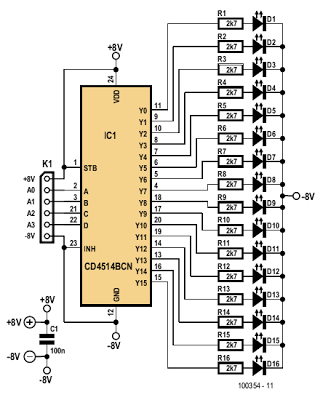
The indicator described here is specifically designed for adjusting the dynamic limiter outlined elsewhere in this edition and checking if the maximum level of the reference voltage (P1) requires modification. A 4-to-16 decoder integrated circuit (IC) of type 4514 is employed to monitor the state of the four-bit up/down counter in the limiter circuit. This IC can be powered from the ±8 V supply voltages of the limiter. The limiter board features a 6-way connector (K5) that provides access to the four counter outputs and the supply voltages. The indicator circuit's connector K1 can be connected to K5 on the limiter board. One output of the 4514 goes high for each unique 4-bit combination on its inputs, while the other outputs remain at logic low. A separate current-limiting resistor is connected in series with each LED. A common cathode resistor could not be utilized here because most LEDs have a maximum reverse blocking voltage of only 5 V, while the supply voltage is 16 V, significantly higher. The 16 LEDs are arranged in a row to provide a fluid indication of the control process. The display can be enhanced by using different colors for the first and last LEDs, such as red for D1 (maximum gain) and green for D16 (minimum gain), with yellow for the remaining LEDs. While observing signals from various sources (TV set, DVD, media player, etc.), the 16 LEDs can be used to monitor the behavior of the limiter and adjust the setting of potentiometer P1 in the limiter circuit. It should be set such that D16 only lights up at the maximum signal level. If this is not achievable and D16 remains lit a significant amount of the time regardless of the position of P1, it will be necessary to increase the value of P1. It is also possible to adjust P1 so that the strongest signal source extends slightly above the control range of the limiter.
The described indicator circuit serves as a crucial component in managing the dynamic limiter's performance by providing visual feedback through an array of 16 LEDs. Each LED corresponds to specific states of the limiter's operation, indicating varying levels of gain. The 4-to-16 decoder IC (4514) plays a vital role in translating the four-bit counter's output into a format suitable for LED activation. The design ensures that each LED is driven independently, preventing potential issues associated with using a common cathode resistor due to the higher supply voltage.
The arrangement of the LEDs allows for a clear visual representation of the limiter's status, facilitating real-time adjustments. The choice of colors for the LEDs enhances the user interface, allowing operators to quickly identify the operational state of the limiter. The use of red for the maximum gain indicator (D1) and green for the minimum gain indicator (D16) provides an intuitive understanding of the gain range, while yellow LEDs indicate intermediate levels.
Connecting the indicator circuit to the limiter's output via the K5 connector ensures seamless integration, allowing for straightforward monitoring and adjustment of the limiter's performance. The circuit's design accommodates various input sources, making it versatile for different applications. The feedback mechanism provided by the LEDs enables operators to fine-tune the potentiometer P1 effectively. By adjusting P1, operators can ensure that the limiter operates within the desired parameters, preventing distortion and maintaining signal integrity across different input levels.
In summary, this indicator circuit is an essential tool for optimizing the performance of the dynamic limiter, providing clear visual feedback and facilitating precise adjustments to maintain optimal signal levels.The indicator described here is specifically designed for adjusting the dynamic limiter described elsewhere in this edition and checking whether the maximum level of the reference voltage (P1) needs to be modified. Her e we use a 4 -to -16 decoder IC (type 4514) to monitor the state of the four-bit up/down counter in the limiter circuit.
This IC c an be powered from the ±8 V supply voltages of the limiter. The limiter board has a 6-way connector (K5) that provides access to the four counter outputs and the sup-ply voltages. Connector K1 of the indicator circuit can be connected to K5 on the limiter board. One output of the 4514 goes high for each unique 4-bit combination on its inputs, while the other outputs remain logic Low.
A separate current-limiting resistor is connected in series with each LED. It was not possible to use a common cathode resistor here because most LEDs have a maximum reverse blocking voltage of only 5 V, while the supply voltage here (16 V) is a good deal higher. The 16 LEDs ar ranged in a r ow pr ov ide a fluid` indication of the control process. You can enhance the display by using different colours for the first and last LEDs, such as red for D1 (maximum gain) and green for D16 (minimum gain), with yellow for the rest of the LEDs.
While observing signals from various sources (TV set, DVD, media player, etc. ), you can easily use the 16 LEDS to monitor the behaviour of the limiter and adjust the setting of potentiometer P1 in the limiter circuit. It must be set such that D16 only lights up at the maximum signal level. If this is not possible and D16 remains lit a good deal of the time regardless of the position of P1, it will be necessar y to increase the value of P1.
Of course, it is also poss-ible to adjust P1 so the strongest signal source extends slightly above the control range of the limiter. 🔗 External reference
The described indicator circuit serves as a crucial component in managing the dynamic limiter's performance by providing visual feedback through an array of 16 LEDs. Each LED corresponds to specific states of the limiter's operation, indicating varying levels of gain. The 4-to-16 decoder IC (4514) plays a vital role in translating the four-bit counter's output into a format suitable for LED activation. The design ensures that each LED is driven independently, preventing potential issues associated with using a common cathode resistor due to the higher supply voltage.
The arrangement of the LEDs allows for a clear visual representation of the limiter's status, facilitating real-time adjustments. The choice of colors for the LEDs enhances the user interface, allowing operators to quickly identify the operational state of the limiter. The use of red for the maximum gain indicator (D1) and green for the minimum gain indicator (D16) provides an intuitive understanding of the gain range, while yellow LEDs indicate intermediate levels.
Connecting the indicator circuit to the limiter's output via the K5 connector ensures seamless integration, allowing for straightforward monitoring and adjustment of the limiter's performance. The circuit's design accommodates various input sources, making it versatile for different applications. The feedback mechanism provided by the LEDs enables operators to fine-tune the potentiometer P1 effectively. By adjusting P1, operators can ensure that the limiter operates within the desired parameters, preventing distortion and maintaining signal integrity across different input levels.
In summary, this indicator circuit is an essential tool for optimizing the performance of the dynamic limiter, providing clear visual feedback and facilitating precise adjustments to maintain optimal signal levels.The indicator described here is specifically designed for adjusting the dynamic limiter described elsewhere in this edition and checking whether the maximum level of the reference voltage (P1) needs to be modified. Her e we use a 4 -to -16 decoder IC (type 4514) to monitor the state of the four-bit up/down counter in the limiter circuit.
This IC c an be powered from the ±8 V supply voltages of the limiter. The limiter board has a 6-way connector (K5) that provides access to the four counter outputs and the sup-ply voltages. Connector K1 of the indicator circuit can be connected to K5 on the limiter board. One output of the 4514 goes high for each unique 4-bit combination on its inputs, while the other outputs remain logic Low.
A separate current-limiting resistor is connected in series with each LED. It was not possible to use a common cathode resistor here because most LEDs have a maximum reverse blocking voltage of only 5 V, while the supply voltage here (16 V) is a good deal higher. The 16 LEDs ar ranged in a r ow pr ov ide a fluid` indication of the control process. You can enhance the display by using different colours for the first and last LEDs, such as red for D1 (maximum gain) and green for D16 (minimum gain), with yellow for the rest of the LEDs.
While observing signals from various sources (TV set, DVD, media player, etc. ), you can easily use the 16 LEDS to monitor the behaviour of the limiter and adjust the setting of potentiometer P1 in the limiter circuit. It must be set such that D16 only lights up at the maximum signal level. If this is not possible and D16 remains lit a good deal of the time regardless of the position of P1, it will be necessar y to increase the value of P1.
Of course, it is also poss-ible to adjust P1 so the strongest signal source extends slightly above the control range of the limiter. 🔗 External reference
